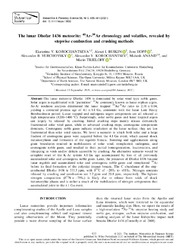The lunar Dhofar 1436 meteorite: 40Ar‐39Ar chronology and volatiles, revealed by stepwise combustion and crushing methods
Korochantseva, Ekaterina V.
Korochantsev, Alexander V.
Anand, Mahesh
Korochantseva, Ekaterina V.; Buikin, Alexei I.; Hopp, Jens; Verchovsky, Alexander B.; Korochantsev, Alexander V.; Anand, Mahesh; Trieloff, Mario, 2021: The lunar Dhofar 1436 meteorite: 40Ar‐39Ar chronology and volatiles, revealed by stepwise combustion and crushing methods. In: Meteoritics & Planetary Science, Band 56, 3: 455 - 481, DOI: 10.23689/fidgeo-4422.
 |
Dokument öffnen: |
The lunar meteorite Dhofar 1436 is dominated by solar wind type noble gases. Solar argon is equilibrated with “parentless” 40Ar commonly known as lunar orphan argon. Ar‐Ar isochron analyses determined the lunar trapped 40Ar/36Ar ratio to 2.51 ± 0.04, yielding a corrected plateau age of 4.1 ± 0.1 Ga, consistent with the lunar Late Heavy Bombardment period. Lunar trapped and radiogenic argon components are all released at high temperatures (1200–1400 °C). Surprisingly, solar noble gases and lunar trapped argon can largely be released by crushing. Initial crushing steps mainly release elementally fractionated solar wind gases, while in advanced crushing steps, cosmogenic components dominate. Cosmogenic noble gases indicate irradiation at the lunar surface; they are less fractionated than solar wind species. We favor a scenario in which both solar and a large fraction of cosmogenic gases were acquired before the 4.1 Ga event, which caused shock metamorphism and formation of the regolith breccia. Sintering and agglutination along grain boundaries resulted in mobilization of solar wind, reimplanted, radiogenic, and cosmogenic noble gases, and resulted in their partial homogenization, fractionation, and retrapping in voids and/or defects accessible by crushing. An alternative scenario would be complete reset of the K‐Ar system 4.1 Ga ago accompanied by loss of all previously accumulated solar and cosmogenic noble gases. Later, the precursor of Dhofar 1436 became lunar regolith and accumulated solar and cosmogenic noble gases and reimplanted 40Ar before its final formation of the polymict impact breccia. The C abundance of the step‐combusted Dhofar 1436 is 555.3 ppm, with δ13C of −28‰ to +11‰. Nitrogen contents released by crushing and combustion are 3.2 ppm and 20.8 ppm, respectively. The lightest nitrogen composition (δ15N = −79‰) is likely due to release from voids of shock metamorphic phases and is rather a result of the mobilization of nitrogen components that accumulated prior to the 4.1 Ga event.
Statistik:
ZugriffsstatistikSammlung:
Schlagworte:
lunar meteorite Dhofar 1436impact melt breccia
argon isotope data
noble gas measurements
This is an open access article under the terms of the Creative Commons Attribution‐NonCommercial‐NoDerivs License, which permits use and distribution in any medium, provided the original work is properly cited, the use is non‐commercial and no modifications or adaptations are made.

